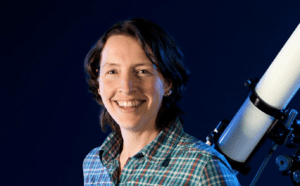
During the third Space Café Canada event, host Jessica West of Project Ploughshares sat down with Dr. Samantha Lawler, an orbital modeller and observational astronomer at the University of Regina to talk about the risks posed by light pollution and other environmental impacts of mega-constellations in outer space.
Dr. Lawler studied at the California Institute of Technology, Wesleyan University, and the University of British Columbia, held postdocs at the University of Victoria, and was a Plaskett Fellow at the National Research Council’s Herzberg Astronomy & Astrophysics Research Centre, also in Victoria. Her research interests include the evolution of the Kuiper Belt, exoplanets, planetary habitability, and artificial satellite visibility. Dr. Lawler has been at the forefront of new research that models the environmental impact of emerging mega-constellations of satellites in space.
What are “mega-constellations”? Why are they emerging? And how do they contribute to light pollution?
Mega-constellations are sets of thousands or tens of thousands of satellites that all serve a common purpose for the same company, usually global Internet service. The Starlink constellation is currently the largest of these, with almost 2,000 satellites in orbit and growing: Batches of 60 satellites are launched every few weeks and the aim is to build up to batches of 500. Currently, Starlink comprises almost half of all active satellites in orbit, and it’s not the only mega-constellation being developed and launched. New satellites are being launched to low Earth orbit (LEO) very, very quickly. We are on track to reach 65,000 satellites within just a few years.
All these satellites create a light pollution problem in space. Satellites are shiny; they reflect light. Satellites in LEO are bright enough to be seen with the naked eye. This used to be kind of interesting to see. But the sheer number of satellites in LEO means that the visibility of satellites is going from neat to blinding.
“It’s like 100 years ago, when you saw a car drive down your road, and that was a big deal. But now you’re living next to an interstate freeway. This is the transition that we’re about to go through.”
Lawler’s slides and videos show what this looks like. Even a glance is terrifying. The night sky has been fundamentally altered by the appearance of hundreds of satellites flying by. And soon there will be many, many more. They raise a particular challenge for astronomers, by blocking stars and obstructing the measurement of asteroids or exoplanets and by creating much more noise in the data. But the biggest problem is that the satellites reflect sunlight, becoming much brighter than distant space bodies. Objects in the Kuiper Belt are 15-million times fainter than a typical satellite that flies through the field of view, easily obscured by the glare.
“Some of these satellites are so bloody bright that they could potentially even damage the very sensitive cameras on these telescopes.”
Why is light pollution a problem for Canada?
Around the world, at any time of the year, hundreds of satellites are visible in the night sky. But most will be seen at latitudes 50 degrees north and south, due to factors relating to geometry, the sun, the seasons, and the orbits chosen by companies for mega-constellations. A few degrees on either side of 50°N is where most Canadians live and Canadian astronomers work.
Is light pollution a problem only for astronomers?
No. Naked-eye sky gazing is essential to humans: we have been doing this for as long as we have been human. So much traditional knowledge and culture from all around the world is contained in the patterns of the night sky. Suddenly, we’re going to have a human-made pattern that is much more visible to us than the natural ones that we have had access to for thousands of years.
“This is a huge piece of humanity that we’re losing.”
Are there technical ways to mitigate the effects of light pollution from satellites?
The only 100% solution is to have fewer satellites in orbit. But, the problem would be much less bad if satellite companies put more effort into trying to mitigate reflections. SpaceX has voluntarily changed the design of some of its satellites by adding visors to make them less reflective. It also tried painting one black, but it overheated and the electronics died. These are voluntary actions; there is absolutely nothing making SpaceX do this, and we have no idea if it will continue or what other companies will do.
“I have no doubt that if engineers were told that they needed to meet some brightness limit, they could do it. But they aren’t being told, so it’s not a priority, and they’re not doing it.”
What other environmental problems are posed by mega-constellations?
Having drastically more objects in just a few key orbits is going to make managing traffic difficult. The risks of collisions between satellites and between space junk will go up, and the satellites themselves will reach end-of-life and become more space junk. Classic Kessler syndrome.
Pollution from launches is another concern. Many more satellites mean many more launches, which leave exhaust in the upper atmosphere. De-orbiting and re-entry are also worrying. SpaceX plans to have their entire fleet of 42,000 Starlink satellites replaced every five years. This means roughly 25 satellites de-orbiting and burning up in Earth’s atmosphere every day. That’s six tons of mostly aluminium added to the upper atmosphere each day. What is that going to do? Nobody knows.
“Nobody has modeled this and nobody has to, because low Earth orbit is not considered an environment.”
No environmental assessment is conducted. SpaceX is running a huge experiment with no environmental oversight.
Do these satellites have value?
Absolutely. These satellites offer very valuable services to many people by providing global Internet. There are a lot of people who have been very much left behind by broadband development and many more who have terrible Internet options. This gap has become especially apparent during the pandemic when so many of us are working from home and taking classes from home. So, it’s vital to have access to high-speed Internet. But the evidence is that those most in need won’t be able to afford it. And this cost does not take into account all of the possible externalities.
“What are we going to lose by gaining this one service?”
The losses will affect everyone, whether or not they use those services.
What are some of the recommendations for governments such as Canada?
Canada alone doesn’t have a lot of leverage. If Canada made companies pay a whole bunch of money to access Canadian customers, because they’re destroying the night sky, those companies could just pull their service from Canada. Countries must work together to produce international regulations.
But Canada should consult with Canadians—with the people who have the most to gain and the most to lose from this service. Northern Canada has a high proportion of First Nations and Inuit people; they need to be consulted. One of the recommendations of the Truth and Reconciliation Commission is that Indigenous people need to be consulted when their resources are being developed. And the night sky – the source of so much traditional knowledge – should definitely be considered a resource. And that is something that could be lost by the introduction of a service that is also badly needed in many communities. So consultation is key, but it’s not happening.
Canada also needs to support astronomers. A lot of resources have been invested in astronomy; we have access to some of the best telescopes in the world. Canadian astronomers are awesome. And if we can’t suddenly do as much astronomy research, then we need support to develop algorithms to get rid of the satellite trails, or new hardware to filter out radio emissions and support Canadian radio astronomy.
But at the end of the day, such externalities must be addressed at the international level.
(A letter submitted to the Canadian government on behalf of Canadian astronomers is available here. A UN Workshop Report on Dark and Quiet Skies is available here. And the SATCON1 report is here)
How can we make decisions about the values and uses of space and possible trade-offs?
Some of the mega-constellation companies have been participating in conferences on this topic, which offer an important way to exchange information with astronomers. But most people live in cities with a lot of light pollution; they don’t see the stars, and they won’t notice this change right away. So how do you get people to care about something that they don’t see? And how do you put a value on light and thousands of years of human knowledge? We need to be talking about these questions in policy discussions.
What can amateur astronomers and regular people do to have a voice on this issue?
Consumer power is important. If you are in a position to have a choice of Internet service, flex your power and do not buy satellite Internet. If you don’t have other options, then tell the provider that the night sky is important to you. And tell more people about what is happening, because most have no idea. Much of the demand for these services comes from rural places that have been left behind by traditional Internet infrastructure. So tell your government that you want investment in other ways of delivering this service – make it a priority.
And for the amateur astronomers out there: show people the night sky. Use your telescope to show people what they will be missing in the next few years. Getting people to care about the sky and also enjoying it yourself is so important. Because we could be about to lose it.
Want to learn more? Use Dr. Lawler’s tool to see how your night sky will be affected by mega-constellations: http://megaconstellations.hanno-rein.de/.
 SpaceWatch.Global An independent perspective on space
SpaceWatch.Global An independent perspective on space




